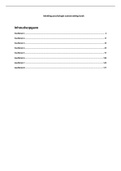Samenvatting
Detailed Summary of Construction And Analysis Of Questionnaires (424242-B-6) {Passed with 7/50 mistakes}
In this selfmade summary you will find all information about the course: Construction of questionairs for international student on Tilburg University (SPSS example included!) Very detailed description of everything. It is super detailed so after reading this you should definilty pass!
[Meer zien]













